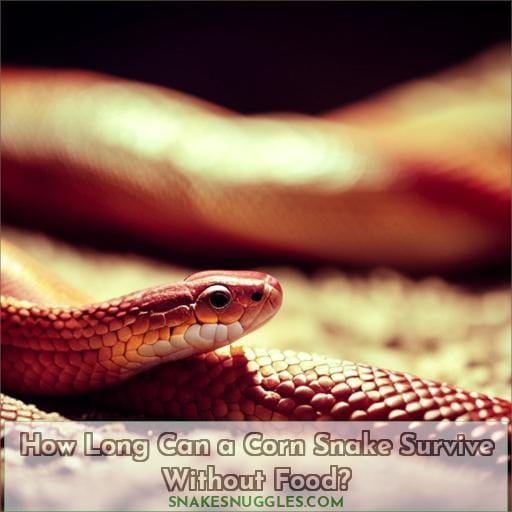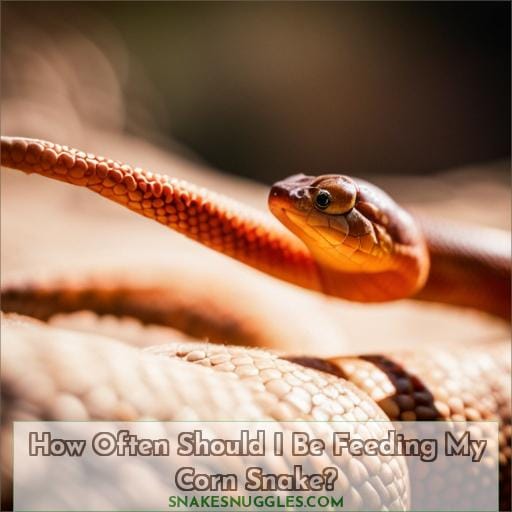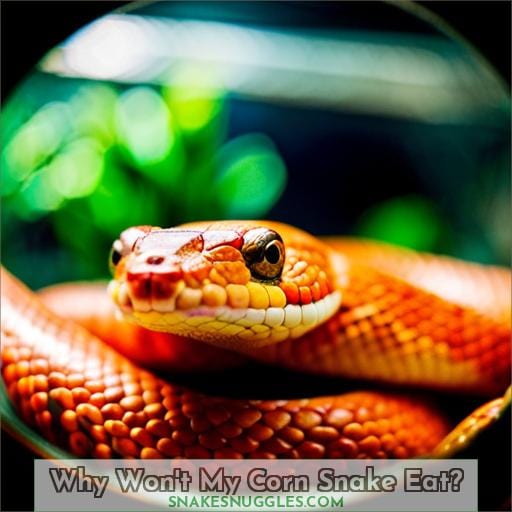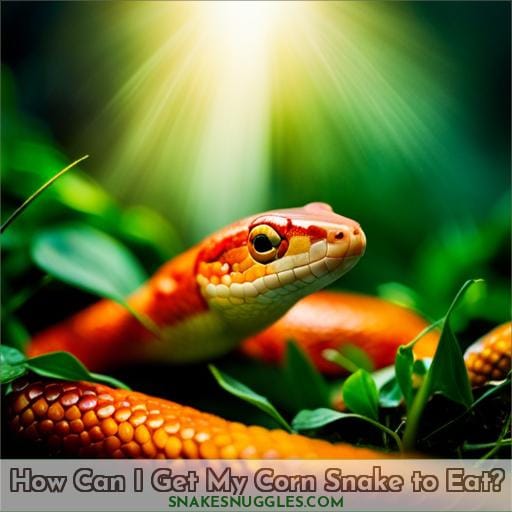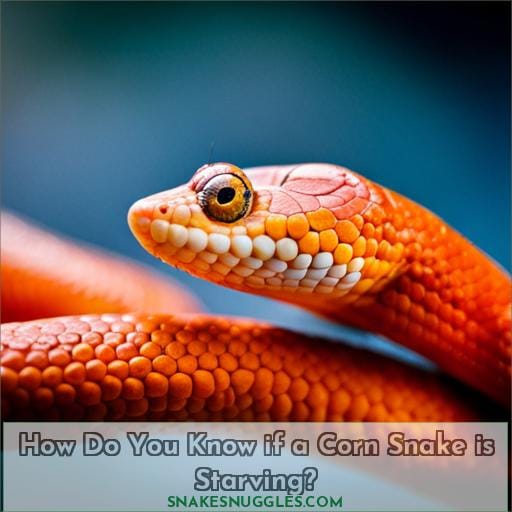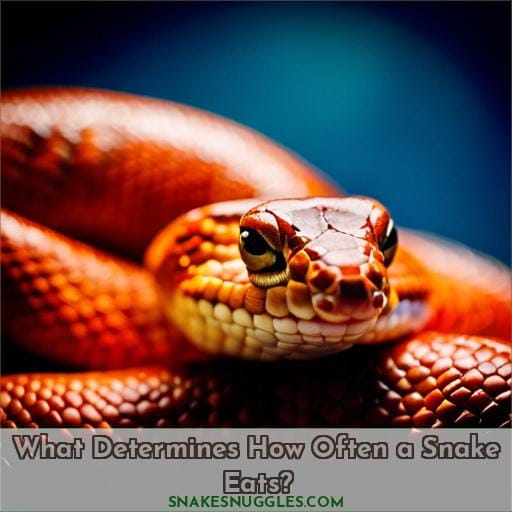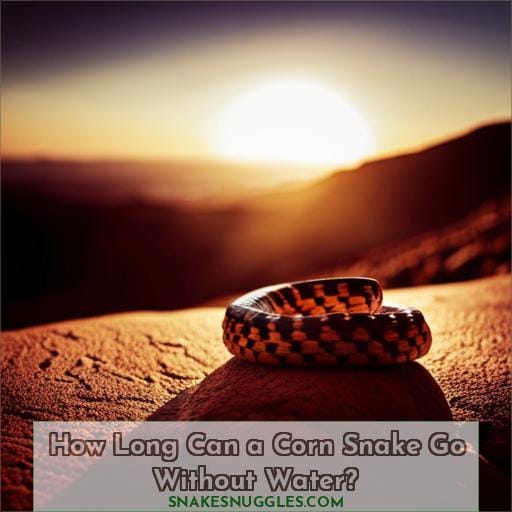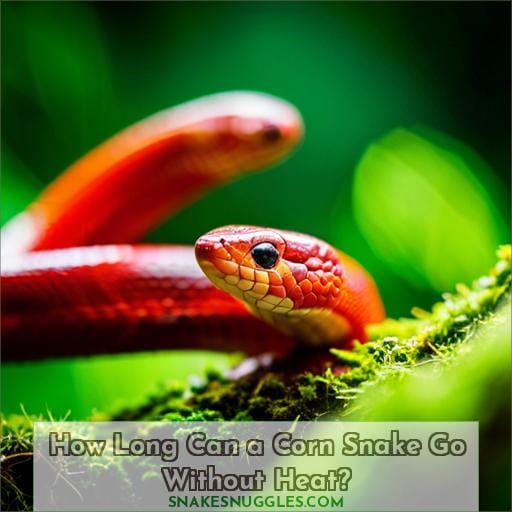This site is supported by our readers. We may earn a commission, at no cost to you, if you purchase through links.
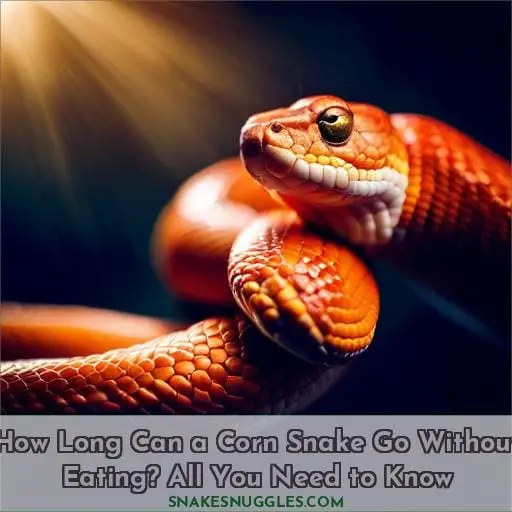 Are you worried that your corn snake isn’t eating enough? You’re not alone. Many owners of these exotic creatures are left wondering how long their snakes can go without food, and what the consequences might be if they don’t feed them in time.
Are you worried that your corn snake isn’t eating enough? You’re not alone. Many owners of these exotic creatures are left wondering how long their snakes can go without food, and what the consequences might be if they don’t feed them in time.
While it’s true that a corn snake can survive for two to three months without food, depending on its age and size, leaving them unfed for too long could lead to serious health risks such as starvation or brumation-related problems.
It’s essential to understand the signs of malnutrition in order to give your pet the best care possible – so let’s take a look at all you need to know about how long a corn snake can go without eating!
Table Of Contents
- Key Takeaways
- How Long Can a Corn Snake Survive Without Food?
- What Are the Consequences if Your Corn Snake Refuses to Eat for Too Long?
- How Often Should I Be Feeding My Corn Snake?
- Why Won’t My Corn Snake Eat?
- How Can I Get My Corn Snake to Eat?
- How Do You Know if a Corn Snake is Starving?
- What Determines How Often a Snake Eats?
- How Long Can a Corn Snake Go Without Water?
- How Long Can a Corn Snake Go Without Heat?
- How Long Can a Baby Corn Snake Go Without Eating?
- Frequently Asked Questions (FAQs)
- Conclusion
Key Takeaways
- Corn snakes can survive 2-3 months without food, with age and size affecting the duration.
- Prolonged lack of food leads to health risks such as starvation and brumation-related issues.
- Feeding frequency is crucial for corn snake health.
- Young and adult snakes have different feeding needs.
How Long Can a Corn Snake Survive Without Food?
You need to ensure your corn snake has the right food, water, and heat to stay healthy – otherwise, they won’t survive. Feeding frequency is key for their health. Both young and adult snakes have different needs.
An improper prey size or live vs. dead food may also affect appetite. Brumation helps conserve energy during winter by slowing down the metabolism rate up to 70%.
Hydration plays a major role in its well-being too. Adults can last 7-12 days without water, but babies should not go beyond a week due to dehydration risk. In terms of temperature requirements, it’s crucial that you maintain proper heating.
Corn snakes are cold-blooded creatures who endure weeks without artificial warmth. During hibernation, it’s important that you mimic natural environment temperatures. This ensures that lack of appetite doesn’t become an issue over time. Other measures like stimulating techniques might be necessary if required.
All these factors help ensure survival when considering how long a corn snake can go without eating.
What Are the Consequences if Your Corn Snake Refuses to Eat for Too Long?
If your corn snake is refusing to eat, it could be the death knell for them if they go too far down that path. Young snakes have a faster metabolism and must feed more frequently than adults in order to maintain health.
Baby corn snakes should not fast longer than a week as this may lead to organ failure and death. Refusal of prey can often be due to cold temperatures, illness, or even improper presentation of food choices such as live vs dead prey size or variety.
Unfortunately for your pet’s well-being, fasting can also cause an increase in appetite stimulation which may make them difficult to feed when you are ready with meals again after extended periods without eating.
During the winter season, especially brumation occurs, which requires a metabolic rate decrease of up to 70%, essential for energy conservation during the hibernation period. However, water consumption is an important part during this time. Signs of brumation will vary depending on the climate, so try not to awaken the baby corn snake until spring signs appear, like increased activity level, slow warming temperature, etc.
Otherwise, consequences would occur related to non-eating phases like a weak immune system, dehydration leading to kidney failure. Always consult a vet if you notice any suspicious behavior from the reptile, especially refusal of a meal because prevention is better than cure here since we are dealing with a life-threatening situation caused by malnutrition.
How Often Should I Be Feeding My Corn Snake?
It is important to maintain a regular feeding schedule for your corn snake as their appetite varies depending on age, temperature, and other factors.
- Feed baby corn snakes every 3-4 days based on the size of prey and metabolic rate.
- Monitor tank temperature and water supply changes, which may influence hunger levels or brumation in older snakes.
- Provide various food items with different sizes, textures, or shapes to stimulate their natural eating preferences.
- Consider offering live prey if the snake refuses to eat pre-killed food, but always use caution when doing so!
A consistent routine will help them adjust faster while allowing you an easier time monitoring activity levels that could indicate illness. Signs such as refusal of meals over multiple weeks or sudden weight loss despite proper feeding frequency should be taken seriously.
If any signs are noticed outside normal behavior, it is best to consult a veterinarian who specializes in reptile care for advice on how best to proceed before further complications arise from malnutrition due to improper dieting habits.
Why Won’t My Corn Snake Eat?
It’s important to understand why your corn snake won’t eat, as fasting for too long can lead to serious health issues. Different factors such as brumation/hibernation, shedding skin, or the way food is served may all play a role in affecting their appetite.
Additionally, food size that is too large or having eaten only 24 hours prior could also be contributing factors. Understanding these variables will help you determine why your corn snake isn’t eating and ensure they receive the nutrition they need for a healthy life.
Brumation/Hibernation
Brumate with care – a hibernation period that’s not properly regulated can mean life or death for your scaly pal. Look out for brumation signs like reduced appetite, decreased activity, and lower metabolic rate.
Fasting risks include organ failure, so ensure hydration needs are met during brumation, and health-sustaining heat is provided consistently throughout the cycle. Feeding frequency should be adjusted according to age, while reptile veterinary advice is essential if temperature regulation isn’t sufficient or the snake shows signs of distress.
Shedding Skin
Your snake may not eat before or after shedding its skin. Shedding signs indicate a time for extra care, including making sure your corn snake is eating correctly and meeting dietary needs. Monitor feeding habits, water intake, and temperature needs carefully to ensure proper health during this process.
Snake behavior can be tricky when it comes to eating; tricks like changing up the food presentation or stimulating appetite with heat can help encourage them to feed on schedule again.
The Way the Food is Served
You should ensure that your corn snake’s food is served in an inviting manner to encourage eating. Vary the serving pattern, prey size and type, as well as the presentation of food. Monitor hunger cues such as the frequency of hiding behavior or lack thereof; fasting periods can lead to organ failure if not monitored properly.
Feeding patterns and habits should be discussed with an exotic vet for proper nutrition advice for snakes.
Food Size is Too Large
Be aware that if the prey size you are offering is too large, it can be harmful to your corn snake’s health. Feeding frequency and live food should reflect age; cold temperatures affect appetite. Appetite stimulation techniques exist for snake skin shedding process or not eating periods – starving a corn snake can cause organ failure and death
! Reptile health and pet care require knowledge of feeding patterns and proper prey sizes – consult a vet if in doubt.
Ate Only 24 Hours Ago
If your corn snake ate less than 24 hours ago, they may not be hungry yet. Fasting risks can occur if the temperature is too low or there’s inadequate water intake. To stimulate appetite, consider raising ambient temps and observe for brumation signs.
If hunger persists, consult a vet about possible illnesses that could prevent eating or other reasons for not eating, such as improper prey size or live vs dead food presentation.
Caring for a corn snake requires being mindful of fasting periods and recognizing signs of hunger that are safe to address through proper techniques.
How Can I Get My Corn Snake to Eat?
If your corn snake won’t eat, it’s important to consider why. Temperature is a key factor in their appetite and activity levels, as well as the size of prey they’re offered. It’s also important to ensure you provide regular meals and follow proper hydration guidelines for water intake.
Lastly, there are techniques available that can help stimulate your pet’s appetite when needed.
To maintain optimal health, corn snakes require specific conditions related to temperature and food availability which must be kept consistent with their natural environment for them to thrive. This includes keeping meal frequency steady so they don’t become too hungry or go without food for too long periods of time due to its effect on metabolism rate changes and organ failure risk if fasting overlong occurs.
Prey size should also be appropriate – large prey items could cause harm if swallowed whole – but not so small that they’ll lose interest entirely. Eating smaller snacks more frequently can increase feeding enthusiasm, particularly during brumation times when metabolic rates tend to decrease up to 70%.
As such, heat requirements should never drop below what is required by the species. This helps keep immune systems at healthy levels even during hibernation fasts. Providing adequate water hydration via fresh drinking sources from trough baths or misting bottles every few days will help keep skin excretions functioning properly.
The use of appetite stimulation treatments like live insects presented in interesting ways, such as hidden within paper towel tubes, have been known to successfully engage picky eaters who may refuse otherwise standard fare offerings.
By understanding these factors, we can create an ideal home environment that keeps our beloved pets happy and healthy!
How Do You Know if a Corn Snake is Starving?
Observing your corn snake’s behavior can provide valuable clues about their health and well-being. Look out for prowling behaviors, such as air tasting or moving between hides more often than usual. Decreased soaking and resting time are also signs of starvation in a corn snake.
Prowling Behavior
Prowling behavior is a warning sign that your corn snake may be starving; watch for its restless movements as it searches for food. Air tasting, moving hides, soaking less, and resting less are signs to look out for.
Furthermore, if the snake’s appetite decreases or it refuses food altogether, then malnutrition could be setting in. Ensure you provide a variety of properly sized prey and maintain an appropriate temperature range to prevent starvation from occurring.
Air Tasting
You can observe a corn snake actively tasting the air with its tongue to determine if it is hungry or not. The air sensing helps regulate body temperature and also indicates prey size and frequency of feeding required for proper survival.
Fasting too long affects metabolism, growth, health, leading to organ failure and death; so monitoring how often one feeds their pet corn snake is important for preventing starvation.
Moving Between Hides
Surprise yourself by watching a corn snake swiftly glide between its hides! A hide is an important element of temperature regulation and fasting for the reptile. Hides provide warmth, help to reduce stress from prey size, or facilitate digestion after eating.
Temperature changes within the hide can indicate whether it’s time to feed your pet again soon. Corn snakes typically choose their favored hide based on temperatures; when they are too warm or cold in one spot, they quickly move to another that suits them better.
Soaking & Resting Less
By reducing the amount of time your corn snake spends soaking and resting, you can help ensure that its eating patterns remain consistent. Fasting for too long can bring serious health risks to a snake; temperature regulation is important as well.
Proper food presentation and prey size also impact appetite, while techniques like appetite stimulation may be necessary in some cases. Keeping all these factors in mind will help keep your corn snake healthy by avoiding fasting dangers which could lead to organ failure or death.
What Determines How Often a Snake Eats?
Having a good understanding of how often to feed your corn snake is essential for its well-being. To determine when a corn snake has had enough to eat, you must consider the consequences of not feeding it adequately and observe certain signs that may indicate it’s full.
Knowing these factors will help ensure your pet stays healthy and happy while in captivity.
How Does a Corn Snake Determine When It Has Had Enough to Eat?
To determine when it’s had enough to eat, how does a corn snake know? Factors like feeding frequency, metabolic rate, temperature mimicry, and prey size affect its appetite.
Adult snakes can survive up to 12 days without water but must be on a regular schedule for food.
Snakes are cold-blooded creatures, so appropriate temperatures must be maintained for hibernation, as well as immune system strength during fasting periods.
What Are the Consequences of Not Feeding for So Long in a Corn Snake?
You could be risking serious health issues if your corn snake goes too long without eating. Fasting can lead to organ failure and death, so it’s important to pay attention to a regular feeding schedule based on age.
If the temperature mimicry is not right, the snake may refuse food or become ill – watch out for signs of illness! Too large of prey can also cause harm as they are unable to properly taste air when their mouth is full.
Feeding frequency should vary by age, while proper prey size must be considered. Live versus dead food plays a big role in appetite stimulation techniques too.
Keep an eye out for any refusal from your pet – don’t let them go past one week without eating; you could save its life!
How Can a Corn Snake Tell When It Has Had Enough to Eat?
A corn snake will indicate that it has had enough to eat by slowing down its eating pace and refusing further food. Meal presentation, food selection, water quality, and temperature regulation all play a role in how much the snake eats.
Improper prey size or improper meal presentation will make the corn snake lose interest in feeding. Fasting for too long can be dangerous, so it’s essential to provide proper nutrition and regulate temperatures accordingly.
The quality of water must also be maintained since hydration aids skin excretion, as well as digestion and absorption of nutrients from meals eaten by the reptile.
How Long Can a Corn Snake Go Without Water?
You may have heard about the dietary habits of corn snakes, but what about their water consumption? Corn snakes need to stay hydrated and take in regular doses of water. Temperature also plays a major role in how much a corn snake needs to drink; being too cold or too hot can be dangerous for them.
It’s important that you understand these aspects when caring for your pet reptile.
Water Consumption Habits of Corn Snakes
Understanding water consumption habits of corn snakes is critical to their survival as they’re cold-blooded and require hydration for proper skin excretion. Adult corn snakes can typically go up to 7-12 days without water, but baby corn snakes can’t last long at all if deprived of hydration.
Regular fasting periods where the snake doesn’t eat should also be counterbalanced with careful monitoring of appropriate hydration levels.
Moreover, temperature control plays an important role in a snake’s feeding habits. When temperatures drop too low during brumation (hibernation), metabolic rates decrease significantly. This results in decreased appetite and faster dehydration due to reduced energy expenditure.
As such, care must be taken that hibernation is properly managed according to seasonal changes.
Corn Snake Water Temperature
It’s critical to monitor the water temperature of your corn snake, as even a slight variation can throw them off their game. Corn snakes require heat sources for digestion and metabolism, so it’s important to keep an eye on food presentation and water quality.
When fasting for long durations during brumation or hibernation periods, make sure that the metabolic rate has slowed down enough before decreasing temperatures too drastically; this could be fatal when done incorrectly.
Water should also always be fresh with no impurities present in order to ensure proper hydration levels–especially important for baby corn snakes who can’t go without it very long!
Keeping all these factors in mind will help you provide the best care possible while ensuring your pet’s safety and wellbeing at all times.
How Long Can a Corn Snake Go Without Heat?
Hibernation is a crucial factor in the survival of corn snakes. It changes their behavior, metabolism, and energy levels, so it’s important to understand what you should do when hibernating your pet. You’ll need to consider how long they must stay in hibernation, the temperatures needed for successful wintering, and whether or not exercise can be beneficial during this time.
Knowing when spring has come is also key to making sure that your corn snake survives until next year.
Should I Hibernate My Corn Snake?
When deciding whether or not to hibernate your corn snake, consider the seasonal changes and behaviors associated with it as well as its metabolic needs.
- Brumation effects must be taken into account.
- Food presentation is a key factor in successful brumation.
- Temperature mimicry should match natural conditions.
- Energy conservation during winter aids in survival.
- The immune system relies on heat for functioning correctly.
Careful consideration of these variables can ensure that your corn snake has an optimal chance of surviving hibernation safely.
Will My Corn Snake Get Enough Exercise During Hibernation?
To ensure your corn snake gets enough exercise during hibernation, it is important to research the expected activity level and create a plan. Feeding frequency should match brumation duration with proper food presentation.
Do I Need to Keep My Snake at a Specific Temperature?
You must keep your corn snake at an ideal temperature to ensure its health and survival. The optimal range is between 75°F and 85°F, while nighttime temperatures should stay above 70°F. Heat regulation allows for proper nutrition, as well as maintaining shedding cycles and feeding frequency; all of which are necessary for a healthy life.
Make sure the habitat has appropriate areas that provide both cool and warm spots to allow your pet choices on regulating their own body temperature. Lastly, monitor the environment regularly with thermometers so you can adjust accordingly when needed.
How Long Do I Need to Keep My Snake in Hibernation?
Hibernation is essential for corn snakes to survive the winter months, so it’s important to understand how long they need to stay in this state. Stimulation techniques, immune system performance, and prey size all require proper temperature control during hibernation.
How Do I Know When Spring Has Come?
As the weather warms up, pay attention to your snake’s behavior for signs that spring has arrived. Look for a decrease in brumation and metabolic changes; these can be seen with increased activity and appetite.
Monitor food presentation closely, as well as water temperature—it should remain consistent even during hibernation. Also, consider heat requirements: if they’re too low, it may not be time to wake yet! Finally, observe how seasonal changes affect the environment around you—these subtle cues can help determine when it is safe to fully emerge from hibernation.
How Long Can a Baby Corn Snake Go Without Eating?
Baby corn snakes typically need to eat more frequently than adults due to their faster metabolism, so it’s important not to let them fast for too long.
- Monitor feeding frequency and adjust as needed based on age.
- Create an appropriate temperature mimicry that mimics natural habitats when entering the brumation period.
- Utilize appetite stimulation techniques if necessary and vary food presentation styles in order to maintain interest in eating.
It is also essential that they have access to clean water at all times, particularly during prolonged fasting periods. Hydration is key for healthy skin excretion processes, which help prevent dehydration-related illnesses or death should the snake refuse food for longer than expected periods of time.
During hibernation season, you will notice a decrease in activity levels. But be sure not to wake up your pet suddenly from its slumber until it has had ample time (usually about one month) to slowly warm itself back up after being inactive throughout wintertime.
Frequently Asked Questions (FAQs)
What Types of Food Should I Feed My Corn Snake?
Feed your corn snake a variety of foods, including rodents and other small animals. Aim for prey that is the same width as your pet’s body to avoid health problems.
What Are the Signs of an Unhealthy Corn Snake?
Signs of an unhealthy corn snake include weight loss, refusal to eat, lethargic behavior such as basking in the same spot for long periods of time or slow movement. Additionally, be on the lookout for changes in skin color and texture, as well as any visible signs of infection or parasites.
How Can I Tell If My Corn Snake Is Shedding?
Signs of shedding in corn snakes include dulling or whitening of the skin, thinning scales, and an increase in rubbing against materials. Look out for clear eyes with a bluish tinge and increased activity levels as well.
How Can I Stimulate My Corn Snake’s Appetite?
Stimulate your corn snake’s appetite by providing appropriate prey size, feeding live or dead food depending on preference and age, presenting the food in an interesting manner, offering feedings on a regular schedule, and after shedding.
What Kind of Enclosure Is Ideal for a Corn Snake?
An ideal enclosure for a corn snake should be secure and spacious, providing plenty of places to hide and explore. It should also feature proper ventilation, temperature regulation, and humidity control — all contributing to the healthful habitat of your pet.
Additionally, ensure that any materials used are non-toxic and smooth so as not to harm your slithering friend’s delicate scales.
Conclusion
It’s essential to understand how long a corn snake can go without eating in order to keep them healthy and safe. If a corn snake goes without food for too long, they can suffer from organ failure and even death.
Young corn snakes have a faster metabolism and must be fed more often, whereas adult corn snakes can go up to 12 days without food. Additionally, corn snakes need water, heat, and a proper hibernation period to survive.
Factors such as food presentation, prey size, and brumation can significantly impact a corn snake’s appetite and health. With the right knowledge and tools, such as a stainless steel tweezer set, you can ensure your corn snake is getting the best care they need to stay healthy and happy.

